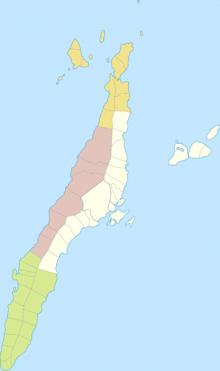
Cebu, officially the Province of Cebu, is a province of the Philippines located in the Central Visayas (Region VII) region, and consists of a main island and 167 surrounding islands and islets. Its capital and largest city is Cebu City, nicknamed "the Queen City of the South", the oldest city and first capital of the Philippines, which is politically independent from the provincial government.

In the Philippines, provinces are one of its primary political and administrative divisions. There are 82 provinces at present, which are further subdivided into component cities and municipalities. The local government units in the National Capital Region, as well as independent cities, are independent of any provincial government. Each province is governed by an elected legislature called the Sangguniang Panlalawigan and an elected governor.

A city is one of the units of local government in the Philippines. All Philippine cities are chartered cities, whose existence as corporate and administrative entities is governed by their own specific municipal charters in addition to the Local Government Code of 1991, which specifies their administrative structure and powers. As of July 8, 2023, there are 149 cities.

Southern Tagalog, designated as Region IV, was an administrative region in the Philippines that comprised the current regions of Calabarzon and Mimaropa, the province of Aurora of Central Luzon, and several cities of Metro Manila. The name remains as a cultural-geographical region only, which exempts Aurora.

Davao de Oro, officially the Province of Davao de Oro, is a province in the Philippines located in the Davao Region in Mindanao. Its capital is Nabunturan. It used to be part of the province of Davao del Norte until it was made a separate province in 1998.

The legislative districts of Cebu are the representations of the province of Cebu in the various national legislatures of the Philippines. At present, the province is currently represented in the House of Representatives of the Philippines by its seven congressional districts, with their respective representatives being elected every three years. Locally, the districts are also allotted two seats in the Cebu Provincial Board, with board members also being elected every three years.

One Cebu (1-CEBU) is a provincial political party based in the province of Cebu. It is headed by Gwendolyn Garcia, governor of Cebu.

Bogo, officially the City of Bogo, is a 6th class component city in the province of Cebu, Philippines. According to the 2020 census, it has a population of 88,867 people.

Elections were held in Central Visayas for seats in the House of Representatives of the Philippines on May 10, 2010.

Museo Sugbo is a museum in Cebu City, Philippines. The museum is located in the former Cebu Provincial Detention and Rehabilitation Center (CPDRC) jail, and is located four blocks away from Plaza Independencia. The museum is owned by the Cebu provincial government.

Local elections were held in the province of Cebu on May 10, 2010 within the Philippine general election. The voters elected a mayor, vice mayor, nine district representatives (including two from Cebu City and the newly formed lone district of Lapu-Lapu City, and town and city councilors as well as two provincial board members came from six provincial districts.

Vicente Rama was a Filipino Visayan legislator, publisher, and writer from Cebu, Philippines. Recognized as the Father of Cebu City, he authored the bill for its cityhood which was approved into law by October 20, 1936. He also founded the leading pre-war Cebuano periodical, Bag-ong Kusog.

The Palawan division plebiscite was a plebiscite held in the province of Palawan, Philippines on March 13, 2021. As required by Republic Act No. 11259, the plebiscite was conducted to consent the residents of Palawan on the proposal to divide the province into three separate provinces: Palawan del Norte, Palawan del Sur, and Palawan Oriental.
Buenaventura Perez Rodriguez was a playwright, the governor of Cebu, Philippines from 1937 until 1940, and a member of the House of Representatives for two terms. He was the first Cebu governor of the Philippine Commonwealth.
Julio Llorente y Aballe was a jurist, the first governor of Cebu, Philippines and the first appointed governor of Samar during the American period, and the only Cebuano to be part of the Propaganda Movement in Spain.
Sotero "Terong" Barte Cabahug was a Filipino lawyer, legislator, politician, and civil servant from Mandaue, Cebu, Philippines. He was awarded Legion of Honor with the rank of Commander. He was governor of Cebu (1934–1937), member of the House of Representatives for Cebu's 2nd district for two consecutive terms (1928–1934), Secretary of Public Works and Communications (1945–1946), member of the Cebu Provincial Board (1952–1954), the 9th Secretary of National Defense (1954–1956), and associate justice of the Court of Appeals (1956–1961).
Isidro Kintanar y Camasura was a Filipino Visayan lawyer, politician, and legislator from Cebu, Philippines. He was elected mayor of the municipality of Argao (1952–1954) and Member of the House of Representatives for Cebu's 4th legislative district (1953–1968).
Agustin Yreneo Artiaga Kintanar was a Filipino Visayan lawyer from Cebu, Philippines who served as Cebu's representative and assemblyman from 1925 to 1941 and from 1945 to 1949.

The 2022 Philippine House of Representatives elections were the 36th lower house elections in the Philippines. The election of the House of Representatives was held on May 9, 2022.

Janice Zamora Salimbangon is a Filipino politician serving as the representative for the 4th district of Cebu since 2019. She is the widow of Benhur Salimbangon who also served as the representative of the said district.















